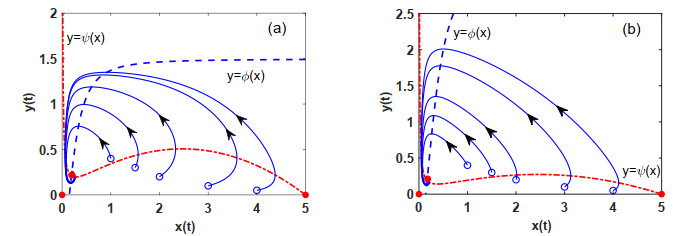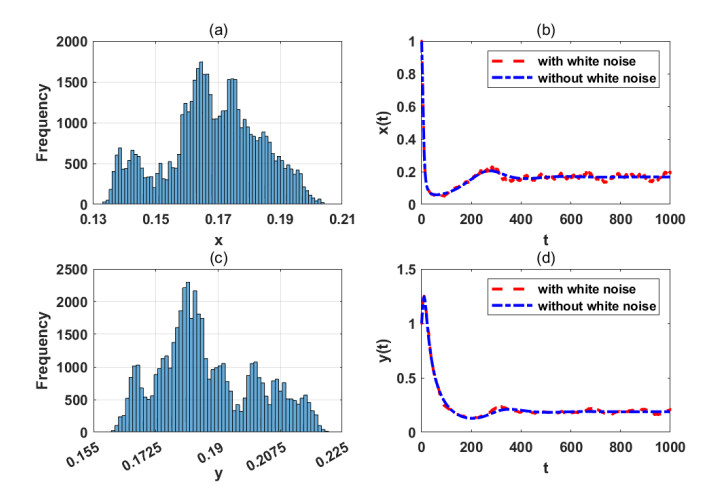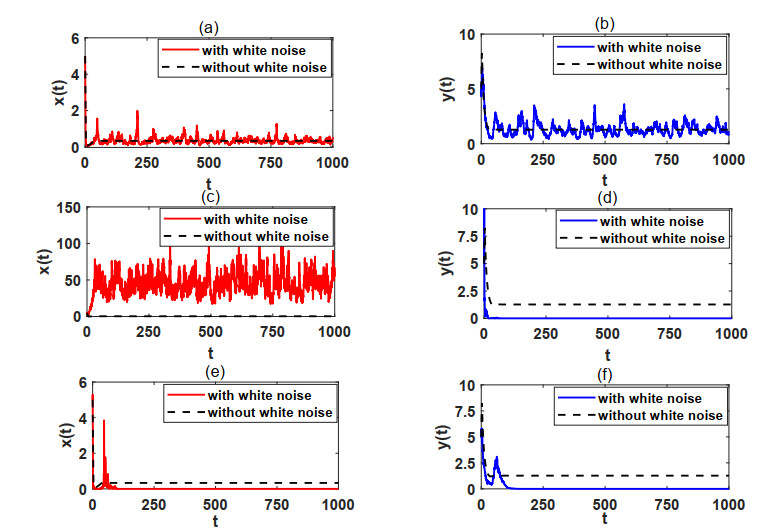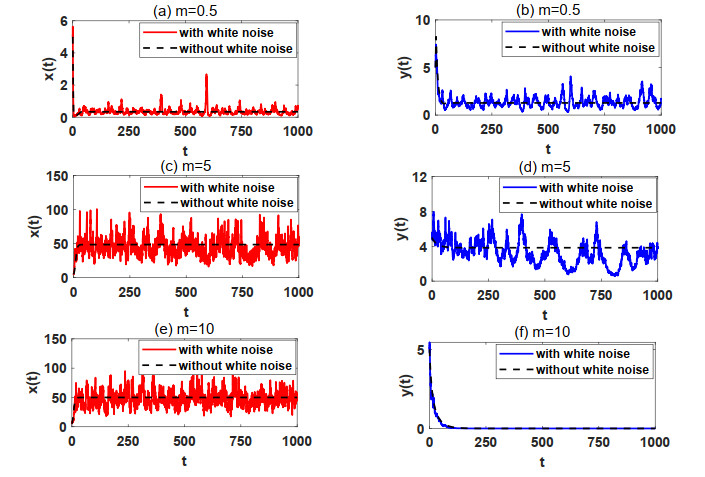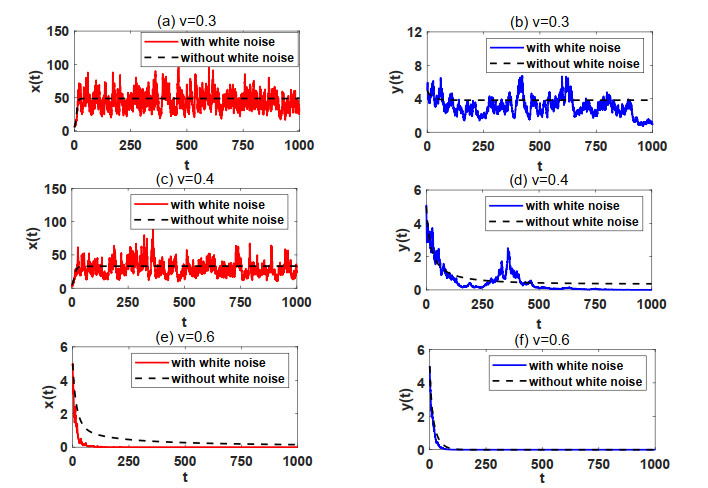1.
Introduction
The study of population dynamics is an important branch of ecosystem models and has attracted the special interest of ecologists and applied mathematics at historical and contemporary stages [1,2]. Mathematical models play a key role in understanding changes in biological systems [3,4] and the effect of control measures [5]. In ecosystems, predation is an important way for species to interact and depend on each other. The pioneer work in mathematics that describes the interplay or dynamics between predator and prey belongs to the Lotka [6] and Volterra [7], which is well known as the Lotka-Voterra model. Subsequently, scholars have refined and enhanced the model in the application of different scenarios and proposed different kinds of uptake functions to characterize the predator's hunting ability [8,9,10,11]. The uptake function with a Holling type is representative and applicable to predation phenomena of different species, ranging from lower organisms such as algae and unicellular organisms to invertebrates and vertebrates, such as Holling-Ⅰ [12], Holling-Ⅱ [13], Holling-Ⅲ [14], Holling-(n+1) [15] and so on. The Holling-Ⅲ functional response showed that the predator's predation reached saturation when the number of prey reached a certain level [14], which is consistent with most of the actual situations. Therefore, it is of a great significance to study the dynamics of a predator-prey model with a Holling-Ⅲ functional response function.
Over the long period of evolution, prey have evolved with a series of anti-predator behaviors. The anti-predator behaviors of prey can be classified into two categories: (ⅰ) defensive counterattacks [16] and (ⅱ) morphological or behavioral changes, including camouflage [17], seeking refuge [18,19], and so on. The benefit of anti-predator behaviors is that they reduce the risk of predation. Red colobus monkeys show siege when they are threatened by chimpanzees [16], cuttlefish choose to camouflage by matching background features [17], northern pigtailed macaques select trees with abundant branches and elevated sleeping locations in order to minimize the threat of predation [18], and white-headed langurs opt for cliff edges or caves as their nocturnal habitats, thus seeking refuge from predators such as leopard cats [19]. Anti-predator behaviors are widespread in nature and are essential to consider in the modeling process. Tang and Xiao [20] proposed a model of the first type of anti-predation behaviors by adding anti-predation terms to reduce the rate of predator growth. It was demonstrated that anti-predator behaviors inhibit predator-prey oscillations and decreased the likelihood of the coexistence between prey and predator [21]. However, many animals lack strong defenses against attacks and they often exhibit the second type anti-predation behavior. An anti-predator model for habitat selection or vigilance was proposed by Ives and Dobson [22], which takes the form:
The existence of the anti-predator effect modulates the reproductive capacity of prey through the factor vx. For example, yellow-eyed juncos exhibit a heightened vigilance by dedicating more time to scanning for predators upon the release of a trained Harris hawk in their vicinity, thus resulting in a reduced time spent foraging for food [23]. It is hypothesized that the diminished feeding rates will ultimately either heighten the likelihood of starvation or hinder the ability to successfully rear offspring. Werner et al. discovered that when bass are present, bluegills will select not rich in resources but more hidden habitats, moreover, bluegills reared in the presence of bass attain only approximately 80% of the mass compared to those raised without the bass present [24]. Additionally, predators pay a price for the anti-predator effect, which is defined by the term e−εv on the predator's hunting ability. Based on this consideration, a prey-predator model with a prey habitat selection is considered in this study.
In reality, population systems are typically subjected to a wide range of random disturbances. May has pointed out that the rate of growth, environmental carrying capacity, coefficient of competition, and other pertinent system parameters are all impacted by environmental noise to differing degrees [25]. The deterministic model has certain limitations, in some situations, frequently yields disappointing results. To more accurately characterize and predict the population ecosystems, it is necessary to investigate population models with stochastic disturbances. In natural system, the stochastic disturbances can be described by white noise [26], colored noise [27], Levy jumps [28], Markov switching [29], and others. Population systems are often subject to environmental fluctuations. Generally speaking, such fluctuations could be modeled by a colored noise. Moreover, if the colored noise is not strongly correlated, then it can be approximately modeled by a white noise, and the approximation works quite well [30]. Mao et al. observed that even the smallest white noise can suppress the population explosion and provided a classical method for the uniqueness of the solution [31]. Ji and Jiang [32] explored a stochastic predatory system that incorporated Beddington-DeAngelis uptake function and discussed the asymptotic property of the system model. Liu et al. [33] put forward a prey-predator system model which followed the Holling type-Ⅱ uptake function in an environment that involved stochastic disturbances. Zhang et al. [34] analyzed a prey-predator system model by considering the Holling type-Ⅱ uptake function and hyperbolic mortality in an environment subject to stochastic disturbances. Liu [35] analyzed the dynamics of a stochastic regime-switching predator-prey model with modified Leslie-Gower Holling-type Ⅱ schemes and prey harvesting. Li et al. [36] proposed a Melnikov-type method for chaos in a class of hybrid piecewise-smooth systems with impact and noise excitation under unilateral rigid constraint. In the present investigation, it is assumed that the environment is influenced by white noise in the modeling process.
The structure of this paper is organized as follows: in Section 2, a prey-predator system model with prey habitat selection and stochastic disturbances is formulated, which is followed by a presentation of some basic notations, definitions, and crucial lemmas used in this study; in Sections 3 and 4, the basic properties and dynamic behavior of the system model with or without stochastic disturbances are investigated; in Section 5, numerical simulations with discussions are presented to illustrate the main results; and finally, the work is summarized and further research directions are put forward.
2.
Mathematical model and basic knowledge
2.1. Mathematical model
When prey habitat selection is considered, the prey-predator model can be described as follows:
where
● x — prey's densities;
● y — predator's densities;
● r — prey's intrinsic growth rate;
● K — prey's environmental carrying capacity;
● v — intensity of anti-predator effect;
● c — conversion efficiency;
● b — interspecific competition coefficient;
● d — natural mortality rate;
● m — efficiency of anti-predator behavior;
● e−m0 — maximum predation rate.
Considering the changes in the natural environment and the universality of random disturbances, we introduce white noise into the Model (2.1) in order to analyze the effect of random disturbances on the Model (2.1). Let
where σi represents the white noise intensity, which describes the strength of random disturbance in the environment. Bi(t) stands for a Brownian motion, i=1,2. Then, the model subject to stochastic disturbances is represented as follows:
All the parameters in Model (2.1) and Model (2.2) are positive. In addition, it is assumed that v≤r and c≥c_≜adevm+m0 in Model (2.1) for biological restriction.
2.2. Basic knowledge
Let us denote the following:
Consider the following:
where B(t) is a standard Brownian motion defined on (Ω,F,{Ft}t≥0,P) equipped with {Ft}t≥0, where F(U(t),t)∈Rl×[0,+∞), G(U(t),t)l×q is a matrix. Define L as follows:
For V(U(t),t)∈C2,1(Rl×[0,+∞),R+), there is
where Vt=∂V∂t, VU=(∂V∂U1,∂V∂U2,⋯,∂V∂Ul), VUU=(∂2V∂Ui∂Uj)l×l. Then,
Definition 1 (Stochastically ultimate boundedness[31]). The solution (u(t),v(t)) is defined as having the property of stochastically ultimate boundedness if for any ε∈(0,1), there exists a constant χ>0 such that
Definition 2 (Extinction and persistence[26]). The species u is defined as extinction when limt→+∞u(t)=0, weakly persistence (in the mean) when ⟨u(t)⟩∗>0, strong persistence (in the mean) when ⟨u(t)⟩∗>0, persistence (in the mean) when ⟨u(t)⟩>0, and weak persistence when limt→+∞supu(t)>0.
Assume that U(t)∈El is a regular time-homogeneous Markov process characterized by the following stochastic differential equation:
The diffusion matrix of the process U(t) is denoted as follows:
Lemma 1 (Ergodic stationary distribution [37]). For a given Markov process U(t)∈El, it is called possessing a unique ergodic stationary distribution μ(⋅) if ∃I⊂El with boundary Γ such that i) min(eig(Λ(U))) is bounded in I and some neighborhood of I; ii) For u∈El∖I, if a path originating from u can reach I in a finite average time τ and supu∈SEuτ<∞, ∀S⊂El, where S is a compact subset.
Remark 1. To establish the condition i), it is sufficient to demonstrate that ∃θ>0 such that
To establish the condition ii), it is crucial to demonstrate the existence of a neighborhood I along with V∈C2 such that LV(u)<0, ∀u∈El∖I.
Lemma 2 ([26]). For a given u(t)∈C[Ω×[0,+∞),R+]:
(1) If ∃ρ0,T>0 with
for t≥T, then
(2) If ∃ρ0, T and ρ with
for t≥T, then ⟨u⟩∗≥ρρ0.
Lemma 3 ([37]). For T0>0, α1>0 and α2>0, it has
3.
Dynamic properties of Model (2.1)
As the population densities are non-negative, the discussion on Model (2.1) is restricted in the region R2/R2−. The equilibrium of Model (2.1) satisfies the following:
Obviously, Model (2.1) always has two equilibria: O(0,0) and EB(¯K,0), where ¯K≜(1−v/r)K. O(0,0) is a saddle and constantly unstable.
Define the following:
Then, x=0 and y=ψ(x) are two x-isolines, y=0 and y=ϕ(x) are two y-isolines.
Since
then it has ψ′(x)→−∞ as x→0. Denote ¯v≜r(1−3√3/a¯K−2). For v≥¯v, there is ψ′(x)≤0 for x∈(0,¯K]; for 0≤v<¯v, it has ψ′(¯K/3)>0. Then, there exists x1∈(0,¯K/3) and x2∈(¯K/3,¯K) such that ψ(x1)=ψ(x2)=0.
Similarly, it has ϕ(0)=−d/b, ϕ′(x)>0 for x∈[0,¯K] and ϕ(x)=0 if and only if x=¯x≜√devm+m0c−adevm+m0. Obviously, ¯x<¯K if and only if c>¯c≜devm+m0(a+¯K−2).
Theorem 1. The boundary equilibrium EB(¯K,0) is globally asymptotically stable for c_≤c≤¯c.
Proof. At EB(¯K,0), the Jacobian matrix is as follows:
and its characteristic roots are as follows:
If c<¯c, then there is λ2<0, then EB(¯K,0) is a node and locally asymptotically stable. If c=¯c, there is λ2=0, then EB(¯K,0) is a saddle-node. Since for c≤¯c, there is ϕ(x)<0, i.e., dy/dt<0 for x∈[0,¯K), then y(t)→0 as t→∞. While dx/dt>0 for x∈[0,K) and y=0, then x(t)→K, i.e., EB(¯K,0) is globally asymptotically stable. □
For c>¯c, there is ¯x<¯K. In such case, EB(¯K,0) is unstable.
Theorem 2. For c>¯c, Model (2.1) has at least one and no more than three interior equilibria. Moreover, if ¯v≤v<r, then the interior equilibrium is unique. In addition, the interior equilibrium ˆE(ˆx,ˆy) is locally asymptotically stable if and only if ϕ(ˆx)<ψ′(ˆx)<bcˆy/(bˆy+d).
Proof. Since there are ψ(¯x)>0 and ψ(¯K)=0 for c>¯c, ϕ(¯x)=0, ϕ(¯K)>0, according to the mediocrity theorem, there exists at least one x∗∈(¯x,¯K) such that ψ(x∗)=ϕ(x∗), i.e., Model (2.1) has at least one interior equilibrium E∗(x∗,y∗), where y∗=ψ(x∗), as illustrated in Figure 1.
For ¯v≤v<r, y=ψ(x) is monotonically decreasing on (¯x,¯K) and y=ϕ(x) is monotonically increasing on (¯x,¯K); therefore, y=ψ(x) and y=ϕ(x) have a unique intersection point, i.e., the interior equilibrium E(x∗,ψ(x∗)) is unique (Figure 1(d)).
For 0<v<¯v, y=ϕ(x) is monotonically increasing and tends to saturation y=ysup≜ce−vm−m0−adab. Alternatively, y=ψ(x) is monotonically decreasing on (0,x1), monotonically increasing on (x1,x2), and monotonically decreasing on (x2,¯K), which forms a S-type on (0,¯K). Thus, y=ψ(x) and y=ϕ(x) have no more than three intersections, i.e., Model (2.1) has no more than three interior equilibria (Figure 1(b)).
For the given interior equilibrium ˆE(ˆx,ˆy), the Jacobian matrix is as follows:
Since
if ϕ(ˆx)<ψ′(ˆx)<bcˆy/(bˆy+d), then there are Trace(JˆE(ˆx,ˆy))<0 and Det(JˆE(ˆx,ˆy)) (i.e., the interior equilibrium ˆE(ˆx,ˆy) is locally asymptotically stable). □
4.
Dynamical properties of Model (2.2)
In this segment, we will examine various characteristics of the stochastic prey-predator model.
4.1. Global positivity
Theorem 3. For ∀(x0,y0)∈R2+, Model (2.2) possesses a unique, global solution (x(t),y(t)) for t>0, which keeps positive with a probability with one.
Proof. Denote x(t)=ep(t), y(t)=eq(t). Consider the following:
It can be verified that Model (4.1) fulfills the Local Lipschitz Condition; then, for given p0=lnx0,q0=lny0, it guarantees the existence of a unique, locally positive solution (p(t),q(t)) on the interval [0,τe), where τe is the time of explosion. The Itˆo formula implies that (x(t),y(t))=(ep(t),eq(t)) is exactly the solution of Model (2.2).
Next, it is sufficient to demonstrate that τe=∞. Let n0 be an integer satisfy (x0,y0)⊂[1n0,n0]. For n≥n0, define the following:
For an empty set ϕ, define infϕ=∞. It is evident that τn increases with n→∞. Define τ∞=limn→∞τn. Then, τ∞≤τe. It is only necessary to prove that τ∞=∞.
By contradiction, it is assumed that τ∞<∞. Then, there exist ε∞∈(0,1) and T∞>0 satisfying P{τ∞≤T∞}>ε∞. Thus, ∃n∞≥n0 such that
Define the following:
Clearly, V(x,y) is nonnegative because s−1−lns≥0 when s>0. Then,
where
Thus, it can be concluded that
By taking expectations after integrating over the interval (0,τn∧T∞), we have the following:
Denote Ωn={w∈Ω|τn=τn(w)≤T∞}. Then, P(Ωn)>ε by Eq (4.2). It can be obtained that x(τn,w) and y(τn,w) equal to either 1n or n for all w∈Ωn. From Eq (4.3), we obtain the following:
which implies
Therefore, we can obtain the following:
□
4.2. Stationary distribution
Define the following:
where δ∈(0,rKa).
Theorem 4. For ∀(x0,y0)∈R2+, Model (2.2) possesses a unique, ergodic stationary distribution for t≥0 if λ>0.
Proof. Since
its diffusion matrix is given by the following
Let θ≜min{σ21x2,σ22y2}. Then, it has
so Lemma 1 condition (i) holds.
To show Lemma 1 condition (ⅱ) holds, set the following:
where H1(x)=−M1(lnx+lny−x−y), H2(y)=12(cx+y)2, M1=2λmax{2,sup(x,y)∈R2+{−b12x3+b2x2−b32y3+b4y2}}>0, and bi>0 (for i=1,2,3,4), will be specified lately. H(x,y) tends to infinity when (x,y) tends to the boundary of R2+, so H(x,y) has a lower bound at (x′,y′)∈R2+. Define
For ∀δ∈(0,rka), there are xy1+ax2≤xy, −cx21+ax2≤−2√δcx+δ(1+ax2) and cx2y1+ax2≤cxy2√a.
By the Itˆo formula, it has the following:
where λ=r−v−d−σ212−σ222−δe−(vm+m0)−[rK+r−v−2e−(vm+m0)√δc]24[rK−δae−(vm+m0)]−(b−d)24b.
Similarly,
Combining (4.4) and (4.5), we have the following:
where b1=rc2K, b2=c2(r+σ212), b3=b, b4=σ222, and b5=cr+M1[e−(vm+m0)+ce−(vm+m0)2√a].
Denote U=[ε,1/ε]×[ε,1/ε] for the given
where M2=sup(x,y)∈R2+{−b12x3+b2x2−b32y3+b4y2+b52(x2+y2)}. Then, R2+∖U can be divided into four regions, R2+∖U=Ω1⋃Ω2⋃Ω3⋃Ω4, in which
Next, we will prove that LW≤−1 on each Ωi (i=1,2,3,4), respectively.
1) For ∀(x,y)∈Ω1, there is xy≤εy≤ε(1+y3). By (4.6) and (4.7), we obtain the following:
2) For ∀(x,y)∈Ω2, there is xy≤εx≤ε(1+x3). By (4.6) and (4.7), we obtain the following:
3) For ∀(x,y)∈Ω3, by (4.6)–(4.8), we obtain the following:
4) For ∀(x,y)∈Ω4, by (4.6)–(4.8), we obtain the following:
To sum up, condition (ⅱ) in Lemma 1 holds. Thus the Model (2.2) possesses a unique, ergodic stationary distribution. □
4.3. Stochastically ultimate boundedness
In this section, we will go into more detail on whether the solution is always bounded.
Theorem 5. Model (2.2)'s solutions are stochastically ultimate bounded.
Proof. Let V1(x,y)=x12+y12. Then,
where
where P0 represents a positive constant, expressed as
Then,
so
Thus,
and
Therefore, for any normal number ε, set χ=P20ε2. Utilizing Chebyshev's inequality[31,37], there is the following:
□
4.4. Extinction and persistence
The objective of this section is to explore the extinction and persistence for the populations.
Lemma 4. For Model (2.2), there are limt→+∞sup{t−1lnx(t)}≤0 and limt→+∞sup{t−1lny(t)}≤0.
Proof. Since
then
Let M(t)=σ1∫t0esdB1(s). M(t) can be regarded as a localized harness that exhibits the following quadratic variance function:
Take μ>1 and γ>1. For k∈N, denote α=e−γk, β=μeγklnk, T=γk. Then, according to the Exponential Martingale Inequality, it has the following:
Since ∑1kμ<∞, then by the Borel-Cantelli lemma[31,37], there exists Ω∈F with P(Ω)=1 and the integer-valued random variable k0(w) such that for any ω∈Ω and k≥k0(ω), there is the following:
Hence,
where Q(x(s))=r−rx(s)K−v−σ212+σ212es−γk+lnx(s). For any s that satisfies 0≤s≤γk, x(s)>0, a k-independent positive constant Φ0 can be found such that Q(x(s))≤Φ0, then, etlnx(t)−lnx0≤Φ0(et−1)+μeγklnk and lnx(t)≤Φ0(1−e−t)+μeγk−tlnk+e−tlnx0. Then,
Let t→∞; we obtain limt→∞suplnx(t)t≤0. In a similar way, one can establish limt→∞suplny(t)t≤0. □
Denote η≜limt→+∞supx(t) and define the following:
Theorem 6. For Model (2.2)'s solution with a given (x0,y0)∈R2+, when Δ1<0, both species x and y will eventually go extinct; when Δ1>0, species x can keep weakly persistent; when Δ1>0 and Δ2<0, species x can keep persistent ⟨x(t)⟩=Δ1 and species y will eventually go extinct; and when Δ1>0 and Δ3>0, both species x and y can keep weakly persistent.
Proof. 1) Since
then
Subsequently, it has
then
Therefore, limt→+∞x(t)=0.
When Δ2<0, it has the following:
Then,
Thus,
i.e.,
Therefore, limt→∞y(t)=0.
When Δ2>0, then for ∀ε1 and ε2>0, ∃T1 such that
hold for t≥T1. Thus,
By the arbitrariness of ε1 and ε2 and Lemma 2, there is limt→∞y(t)=0.
2) By contradiction. Assume Σ={limt→∞supx(t)=0} with P(Σ)>0. Thus,
Therefore, limt→∞supt−1lnx(t)=r−v−σ212=rKΔ1>0. That means that limt→∞supt−1lnx(t)>0 holds for any w∈Σ. There is an inclusion relation Σ⊆{w:limt→∞supt−1lnx(t)>0}, then P{w:limt→∞supt−1lnx(t)>0}≥P(Σ)>0, which contradicts to limt→∞supt−1lnx(t)≤0. Therefore, species x is weakly persistent.
3) It is known that y(t) is extinct as limt→∞y(t)=0 when Δ2<0. From limt→+∞lnx0t=0, it is known that for ∀ε3,ε4>0, ∃T2 such that −ε3≤−e−(vm+m0)xy1+ax2≤ε3 and −ε4≤lnx0t≤ε4 hold for t≥T2. Obviously,
Based on Lemma 2, it can be deduced that ⟨x(t)⟩∗≤Kr(r−v+ε3+ε4−σ212) and ⟨x(t)⟩∗≥Kr(r−v−ε3−ε4−σ212). Therefore, ⟨x(t)⟩=Kr(r−v−σ212)=Δ1>0 (i.e., species x keeps in persistence (in the mean)).
4) Similarly, by using the converse method, one can show that y is also weakly persistent. □
5.
Numerical simulations
This section presents numerical simulations to illustrate the theoretical consequences presented in the study.
5.1. Verification of the main results
For Model (2.1) with the model parameters r=0.4, K=100, v=0.36, m=0.5, m0=0.1, a=15, c=0.8, b=0.02 and d=0.01, there exist three interior equilibria: E∗1(0.26,0.46), E∗2(2.5,1.5) and E∗3(7.5,1.5), where E∗1 is a locally asymptotically stable focus, E∗2 is a saddle and unstable, and E∗3 is a locally asymptotically stable nodel, as illustrated in Figure 2.
For Model (2.2), let consider the following discrete form [38]:
where ε1j, ε2j follow N(0,1), j=1,2,⋯,n. Take σ1=0.02, σ2=0.01, δ=0.0001. For the above model parameters, there is λ=−0.00286<0, and the condition in Theorem 4 does not hold. When v increases (e.g. v=0.38), Model (2.1) has a unique interior equilibrium E∗(0.193,0.213), which is a globally asymptotically stable focus, as presented in Figure 3(a). In such case, the condition in Theorem 4 does not hold due to λ=−0.00136. For a=8, Model (2.1) has a globally asymptotically stable focus E∗(0.155,0.2), as presented in Figure 3(b). In such case, there is λ=0.000144>0, and the condition in Theorem 4 holds. As depicted in Figure 4, for Model (2.2), there exists an ergodic stationary distribution. It is observed that (x(t),y(t)) is stable at (0.155,0.2) without white noise. x(t) varies around 0.155 and y(t) fluctuates around 0.2 when the white noise is presented.
5.2. Impact of the noise level and parameters
For Model (2.1) with the model parameters r=0.6, K=100, a=2, v=0.3, m=0.5, m0=0.01, c=0.8, b=0.01 and d=0.05, there is a unique interior equilibrium E∗(0.1914,0.208), which is locally asymptotically stable.
Different levels of white noise are set to illustrate how white noise affects Model (2.2)'s dynamics. Taking σ1=0.2, σ2=0.1, it has Δ1>0, Δ3>0. Then, species x and species y can keep in a weak persistence, as shown in Figure 5(a), (b). This means that the white noise will have little impact on the populations. Let σ2→0.8; it has Δ1>0, Δ2<0. Therefore, species x can keep in persistence (in the mean), while species y will eventually go extinct, as shown in Figure 5(c), (d). It is evident that a larger white noise induces the predator to be eventually extinct. Let σ1→0.8; it has Δ1<0. Then, species x and species y will eventually go to extinction, as shown in Figure 5(e), (f). Make it clear that the higher the noise level, the more significant the impact on the species of prey.
The predator's hunting ability is affected by a term e−vm, which decreases when m or v increases. For the parameter m, we select a range of diverse values and take σ1=0.2, σ2=0.1. The solution is presented in Figure 6. It is evident that x(t) greatly increases while y(t) increases to be a lesser extent when m rises from 0.5 to 5. There is little change in x(t) when m increases from 5 to 10, while y(t) will change from weakly persistent to eventually extinct. As a result, a modest increase in m benefits y, a large increase in m leads to the extinction of y, and an increase in m promotes the growth of x.
By varying the parameter v, the solutions are presented in Figure 7. Obviously, for a smaller v, species x and species y are both persistent; species y becomes extinct when v increases, and when the anti-predator level becomes excessively strong, species x and species y will eventually go extinct.
6.
Conclusions
The current work explored a Holling-Ⅲ prey-predator model by incorporating prey habitat selection in an environment with stochastic disturbances. For the model without stochastic disturbances, it was shown that O(0,0) is constantly unstable, while E(¯K,0) is stable when c≤¯c≜devm+m0(a+¯K−2). Additionally, it was shown that Model (2.1) possesses not more than three interior equilibria, and the interior equilibrium ˆE(ˆx,ˆy) is locally asymptotically stable if and only if ϕ(ˆx)<ψ′(ˆx)<bcˆy/(bˆy+d).
Additionally, we investigated the dynamics of Model (2.2). By devising an appropriate Lyapunov function, it obtained the conditions for an ergodic stationary distribution. Furthermore, it was demonstrated that Model (2.2)'s solutions are stochastically, eventually bounded. The results suggest that white noise will eventually cause the extinction of prey and predators when it has a large impact on the prey x(t) (Δ1<0). When the white noise has more impact on the predators and less disturbance to the prey, the prey can persist (in the mean), and the predators become extinct (Δ1>0, Δ2<0). The prey and the predator are weakly persistent when white noise has a small effect on them.
Compared to deterministic models, it is well known that sometimes less intense white noise contributes to the survival of prey; however, white noise with a high intensity is unfavorable to the survival of the population. When the hunting ability of the predator is affected by the e−vm term, an increase in m favors the growth of x, a small increase in m would benefit y, while a large increase in m would lead to the demise of y. The population survival is significantly impacted by anti-predatory behavior. It indicated that x(t) and y(t) can persistently survive when the anti-predator level is small. The population y(t) becomes extinct with an increase of the anti-predator level. The prey and predator eventually go extinct when the anti-predator level becomes excessively strong. Incorporating habitat selection and white noise interference into predator-prey models allows for more accurate estimates of changes in natural populations and a deeper understanding of the mechanisms of species interactions and ecological balance. The results suggest that populations may tend to go extinct when the white noise is high or the habitat selection behavior is strong. Therefore, we can carry out an early warning and take effective intervention and protection measures, such as establishing protected areas, improving the habitat environment, controlling the intensity of the white noise interference, and so on.
Use of AI tools declaration
The authors declare they have not used Artificial Intelligence (AI) tools in the creation of this article.
Acknowledgement
The work was supported by the National Natural Science Foundation of China (No. 11401068).
Conflict of interest
The authors declare there is no conflicts of interest.
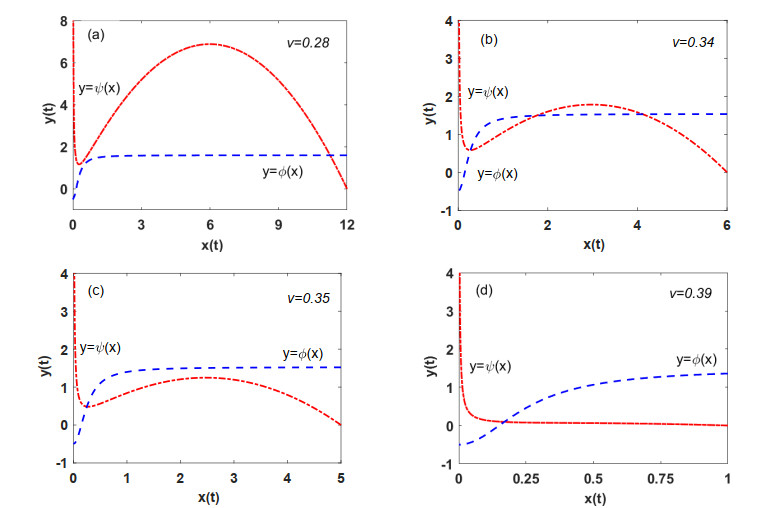









 DownLoad:
DownLoad:

